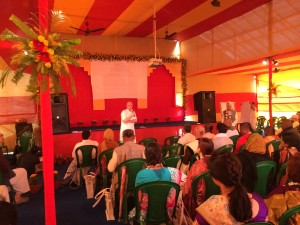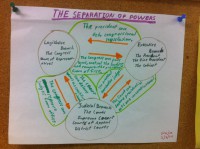
Click here to view the video on YouTube.
Memories of Srila Prabhupada in New Vrindaban – Rasa lila dasi.
My initiation [in July 1974] was a wonderful moment. It was one of those moments that Srutakirti describes – when you’re so bewildered you can’t remember even your own name. To be in front of Srila Prabhupada for the first time was that kind of a feeling.
The devotees in New Vrindavan had put Prabhupada’s vyasasana on a landing about halfway up the stairs leading to Kirtanananda’s cabin [at Bahulaban]. To get your beads from Prabhupada, you had to climb up those stairs. It was very dramatic. The moment was so awesome you felt like you were climbing Mount Sumeru.
The night before, my husband, Narada Muni prabhu, had jokingly said, “And you better get a nice name from Srila Prabhupada.” I said, “Well, yeah, I hope so. I’ll try, what can I say?” So, when I went to get my beads, the sounds system was reverberating and I could barely hear His Divine Grace’s words. Besides that, I was practically stunned anyway. I thought I heard him say that my name was Rasa Lila but I wasn’t sure. I heard all the devotees gasping and cheering. In those days we were studying Krishna Book intensely and we had contests and quizzes about it.
When Prabhupada spoke my name, I experienced what he describes about the gopis during the rasa-lila – that as they sang and danced, their movements, their smiling , their clothes, their earrings, and their hair with flowers combined together to appear like clouds, snow, thunder and lightning. That passage flashed through my mind. When he said my name it was an experiential moment. Even though I wasn’t positive what he had said, that was what I experienced. I walked down the stairs stunned and asked someone, “What did Prabhupada say my name is?” It was incredible. In one moment Prabhupada can reveal the spiritual world to you. That’s his potency.
 Blissful devotees making plans for the benefit of the whole society under the direction of the Paramahamsa Acarya His Divine Grace Bhaktivedanta Swami Srila prabhupada. Read more ›
Blissful devotees making plans for the benefit of the whole society under the direction of the Paramahamsa Acarya His Divine Grace Bhaktivedanta Swami Srila prabhupada. Read more ›  Blissful devotees making plans for the benefit of the whole society under the direction of the Paramahamsa Acarya His Divine Grace Bhaktivedanta Swami Srila prabhupada. Read more ›
Blissful devotees making plans for the benefit of the whole society under the direction of the Paramahamsa Acarya His Divine Grace Bhaktivedanta Swami Srila prabhupada. Read more ›  A fantastic seminar on Kirtan, with all very appropriate quotes and stories about how Srila Prabhupada wanted Kirtan conducted.
A fantastic seminar on Kirtan, with all very appropriate quotes and stories about how Srila Prabhupada wanted Kirtan conducted.  These devotees all live in or near the developing community of New Varshana, near Balta, about 100 km north of Odessa
These devotees all live in or near the developing community of New Varshana, near Balta, about 100 km north of Odessa 

 Yesterday, HH Birkrishna Goswami maharaj visited the TOVP and unveiled the Sphere - a very cool gadget that attaches to your iPhone and takes a 360 degree photo of any location! Wait for the embeding below to load and use your mouse to click and drag through the 360 degree experience of the TOVP!
Yesterday, HH Birkrishna Goswami maharaj visited the TOVP and unveiled the Sphere - a very cool gadget that attaches to your iPhone and takes a 360 degree photo of any location! Wait for the embeding below to load and use your mouse to click and drag through the 360 degree experience of the TOVP! 








 Saturday night is elephant procession night in Mayapur, where we are right now. Little Radha Madhava go out for a tour of the ISKCON campus.
Saturday night is elephant procession night in Mayapur, where we are right now. Little Radha Madhava go out for a tour of the ISKCON campus.  ISKCON Leadership Sanga Day Seven - Maha Kirtan
ISKCON Leadership Sanga Day Seven - Maha Kirtan  In Vrindavana Dham
In Vrindavana Dham 

